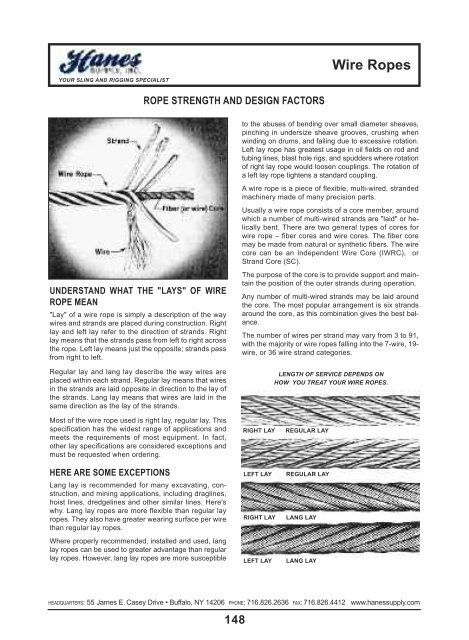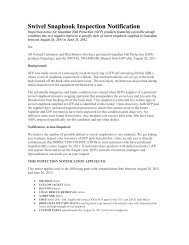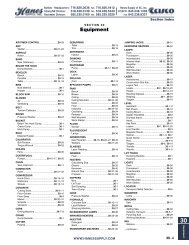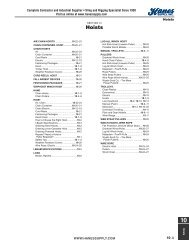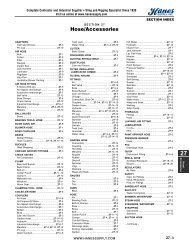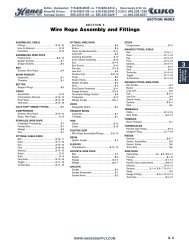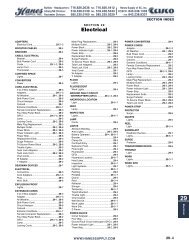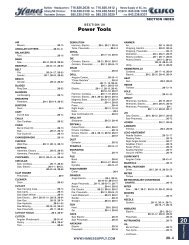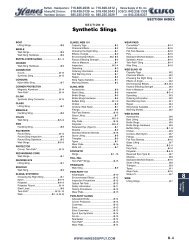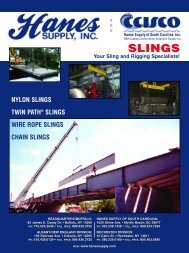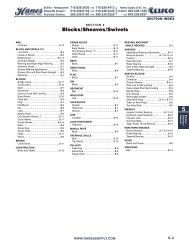twin-path® slings in action - Hanes Supply, Inc
twin-path® slings in action - Hanes Supply, Inc
twin-path® slings in action - Hanes Supply, Inc
- No tags were found...
You also want an ePaper? Increase the reach of your titles
YUMPU automatically turns print PDFs into web optimized ePapers that Google loves.
YOUR SLING AND RIGGING SPECIALISTWire RopesROPE STRENGTH AND DESIGN FACTORSUNDERSTAND WHAT THE "LAYS" OF WIREROPE MEAN"Lay" of a wire rope is simply a description of the waywires and strands are placed dur<strong>in</strong>g construction. Rightlay and left lay refer to the direction of strands. Rightlay means that the strands pass from left to right acrossthe rope. Left lay means just the opposite; strands passfrom right to left.Regular lay and lang lay describe the way wires areplaced with<strong>in</strong> each strand. Regular lay means that wires<strong>in</strong> the strands are laid opposite <strong>in</strong> direction to the lay ofthe strands. Lang lay means that wires are laid <strong>in</strong> thesame direction as the lay of the strands.Most of the wire rope used is right lay, regular lay. Thisspecification has the widest range of applications andmeets the requirements of most equipment. In fact,other lay specifications are considered exceptions andmust be requested when order<strong>in</strong>g.to the abuses of bend<strong>in</strong>g over small diameter sheaves,p<strong>in</strong>ch<strong>in</strong>g <strong>in</strong> undersize sheave grooves, crush<strong>in</strong>g whenw<strong>in</strong>d<strong>in</strong>g on drums, and fail<strong>in</strong>g due to excessive rotation.Left lay rope has greatest usage <strong>in</strong> oil fields on rod andtub<strong>in</strong>g l<strong>in</strong>es, blast hole rigs, and spudders where rotationof right lay rope would loosen coupl<strong>in</strong>gs. The rotation ofa left lay rope tightens a standard coupl<strong>in</strong>g.A wire rope is a piece of flexible, multi-wired, strandedmach<strong>in</strong>ery made of many precision parts.Usually a wire rope consists of a core member, aroundwhich a number of multi-wired strands are "laid" or helicallybent. There are two general types of cores forwire rope – fiber cores and wire cores. The fiber coremay be made from natural or synthetic fibers. The wirecore can be an Independent Wire Core (IWRC), orStrand Core (SC).The purpose of the core is to provide support and ma<strong>in</strong>ta<strong>in</strong>the position of the outer strands dur<strong>in</strong>g operation.Any number of multi-wired strands may be laid aroundthe core. The most popular arrangement is six strandsaround the core, as this comb<strong>in</strong>ation gives the best balance.The number of wires per strand may vary from 3 to 91,with the majority or wire ropes fall<strong>in</strong>g <strong>in</strong>to the 7-wire, 19-wire, or 36 wire strand categories.RIGHt laYLENGTH OF SERVICE DEPENDS ONHOW YOU TREAT YOUR WIRE ROPES.ReGUlaR laYHERE ARE SOME EXCEPTIONSLang lay is recommended for many excavat<strong>in</strong>g, construction,and m<strong>in</strong><strong>in</strong>g applications, <strong>in</strong>clud<strong>in</strong>g dragl<strong>in</strong>es,hoist l<strong>in</strong>es, dredgel<strong>in</strong>es and other similar l<strong>in</strong>es. Here'swhy. Lang lay ropes are more flexible than regular layropes. They also have greater wear<strong>in</strong>g surface per wirethan regular lay ropes.Where properly recommended, <strong>in</strong>stalled and used, langlay ropes can be used to greater advantage than regularlay ropes. However, lang lay ropes are more susceptibleleft laYRIGHt laYleft laYReGUlaR laYlanG laYlanG laYHEADQUARTERS: 55 James E. Casey Drive • Buffalo, NY 14206 PHONE: 716.826.2636 FAX: 716.826.4412 www.hanessupply.com148


